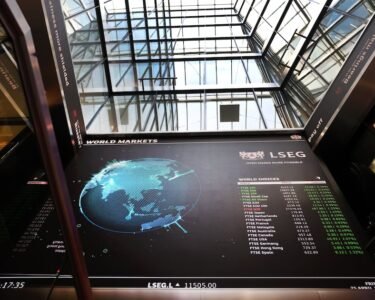India’s “loyal retail traders” are being tested like never before, says Chiranjivi Chakraborty on Bloomberg. A long stock market boom ran into trouble in September, when an unanticipated economic slowdown and analysts’ downgrades to companies’ earnings forecasts knocked India’s richly priced shares – $1.2 trillion has since been wiped off valuations. Global funds withdrew an estimated $26 billion between October and February.
Local investors had kept things ticking along, but even they now appear to be losing enthusiasm, with inflows into domestic mutual funds down 30% since a record high in October. India has been an emerging-market darling in recent years, with the BSE Sensex Index surging 187% between the March 2020 Covid trough and September 2024. Yet, since then, the index has slipped more than 10%.
Many small investors in the Mumbai bourse only got into investing during the Covid-era boom, making this their first market slump, says Veena Venugopal in the Financial Times. Local fund managers are feeling pessimistic, with no immediate “triggers” for a recovery in view and plenty of risk as Donald Trump prepares to unveil new “global tariffs”. “India’s loss is China’s gain.” Global money managers have been distracted by Chinese technology, with Hong Kong’s Hang Seng Tech Index rallying 25% this year amid the DeepSeek mania.
Sign up to Money Morning
Don’t miss the latest investment and personal finances news, market analysis, plus money-saving tips with our free twice-daily newsletter
Don’t miss the latest investment and personal finances news, market analysis, plus money-saving tips with our free twice-daily newsletter
India’s NSE Nifty 50 suffered five straight months of losses through February, its worst losing streak since 1996, says Reuters. Smaller stocks have been especially hard hit, with the Nifty small-cap 100 index dropping 22% from September’s record high.
IT is the latest target, with foreign portfolio investors selling $3.5 billion worth of shares during the first half of March. A large chunk of Indian tech revenue comes from the US, leaving the sector exposed to Trump’s tariff whims.
Has India hit bottom?
By global standards, Indian stocks remain among the world’s priciest, says Craig Mellow in Barron’s. But recent losses arguably constitute a “healthy correction”, with price/earnings (p/e) ratios back to historical averages. State spending “sputtered” after elections last year but shows signs of “picking up again”.
India’s exports are dominated not by goods but by services, which do not attract as much of Trump’s ire. And with a median age of 28 (compared with 38 in China) a demographic dividend is coming through.
Indeed, the BSE Sensex has staged a 6.5% rally since the start of the month, but buying in still requires bravery. “The last shoe to drop will be when retail investors capitulate and sell,” says Arthur Budaghyan of BCA Research. He predicts “at least another 15% drawdown in Indian stocks” before the bottom is in.
This article was first published in MoneyWeek’s magazine. Enjoy exclusive early access to news, opinion and analysis from our team of financial experts with a MoneyWeek subscription.




